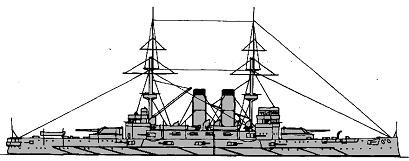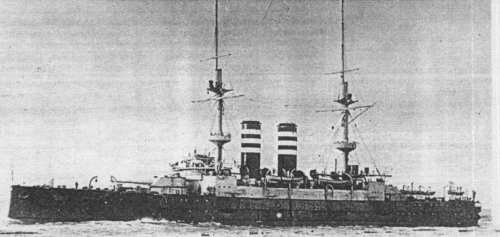

Mikasa 1902
| Name | No | Yard No | Builder | Laid down | Launched | Comp | Fate |
| 三笠 [Mikasa] | 273 | Armstrong, Elswick, UK | 24.1.1899 | 8.11.1900 | 1.3.1902 | stricken 20.9.1923, preserved |
|
Displacement normal, t |
15140 |
|
Displacement full, t |
15179 |
|
Length, m |
122.0 pp 126.5 wl 131.7 oa |
|
Breadth, m |
23.2 |
|
Draught, m |
8.28 |
|
No of shafts |
2 |
|
Machinery |
2 VTE, 25 Belleville boilers |
|
Power, h. p. |
15000 |
|
Max speed, kts |
18 |
|
Fuel, t |
coal 1521 |
| Endurance, nm(kts) | 9000(10) |
|
Armour, mm |
Harvey nickel steel - belt: 229 - 102, bulkheads: 356 - 152, upper belt: 152, casemates: 152 - 51, deck: 76 - 51, barbettes: 356 - 203, turrets: 254 - 203, CT: 356 - 102 |
|
Armament |
2 x 2 - 305/40 Armstrong G, 14 x 1 - 152/40 Armstrong Z, 20 x 1 - 76/40 Armstrong N, 8 x 1 - 47/40 3pdr Hotchkiss Mk I, 4 x 1 - 47/30 21/2pdr Hotchkiss Mk I, 4 - 450 TT (beam) |
|
Complement |
830 |
Project history: Mikasa was the last of the four battleships to be ordered under the 1896 Ten Year Programme. The design was very similar to the preceding classes, exhibiting only minor differences, mainly to the protection scheme. The main armament was given alternative systems of handling in case of breakdown - electric, hydraulic or manual, and like the previous ships the guns could be loaded at any angle of elevation, irrespective of the training angle. The 305mm guns could fire at the rate of three shells every two minutes while magazine storage was provided for 240 shells.
The number of 152mm guns carried was the same as in the previous vessels but they had greater protection. Ten of the 152mm were sited in a box battery on the main deck, rather than in lightly protected casemates on the upper deck. This meant that any shells approaching from behind the gun had first to penetrate the armour on the far side before reaching the gun. Previously it had been possible for a shell to penetrate between two casemates, and then only to be faced by the thin 51mm armour at the rear of the casemate on the opposite side. This box battery was given extra protection fore and aft by extending the armoured bulkheads to the upper deck. The eight 76mm guns sited broadside on the upper deck were also afforded some protection by the resiting of the 25mm splinter deck on the upper deck.
Ship protection: Main belt placed on full ship length and was 2.4m high, its thickness amidships was 229mm (127mm at lower edge) decreasing consequently to 178 and 102mm near ship ends. It connected with main gun barbettes by 356-152mm bulkheads. Upper 63m belt was 152mm thick and 2.3m high. Casemates had 152mm face and 51mm rear armor. Barbettes had 356mm thickness over and 203mm under main deck. Turrets had 254mm faces, 203mm sides and rears and 102mm roofs. CT had 356mm sides and 102mm roof. 51mm armoured deck over citadel connected with lower edge of main belt by 76mm slopes. It had turtleback form outside barbettes and had 76-51mm thickness.
Modernizations: 8.1908: - 2 x 2 - 305/40, 14 x 1 - 152/40; + 2 x 2 - 305/45 41-shiki, 14 x 1 - 152/45 41-shiki
Naval service: Flagship of admiral Togo. She was sunk 29.9.1905 in Sasebo as a result of explosion of aft magazines, salvaged 7.8.1906, repaired and rearmed by new main guns. Mikasa was again commissioned 24.8.1908. To the First World War beginning ship has become outdated, but continued to be in a rank of battleship till 1.9.1921, then she was reclassified to 1st class coast defence ship. 17.9.1921 Mikasa ran aground at Askold island near Vladivostok, but have been salvaged and repaired. She was stricken according to the Washington agreement. In 1926-1945 she was a floating museum but later was neglected and partially scrapped. She was restored in 1960-1961 and established on a shore (covered with earth on a waterline). Mikasa is preserved to this day as a memorial.

Mikasa 1902
Many thanks to Wolfgang Stöhr for additional information on this page.
© Ivan Gogin, 2008-14